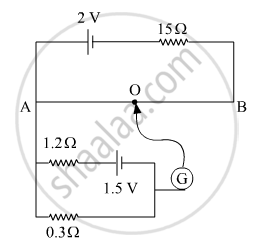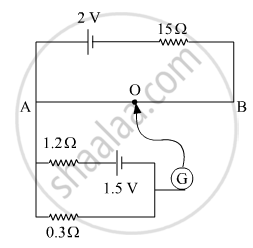Advertisements
Advertisements
प्रश्न
In the following potentiometer circuit, AB is a uniform wire of length 1 m and resistance 10 Ω. Calculate the potential gradient along the wire and balance length AO (= l).

उत्तर

Potential space gradient = `V_(AB)/I`
Using Kirchhoff’s rules,
`2=Ixx15+Ixx10=Ixx25=>I=2/25=0.08 A=>V_(AB)=Ixx10=0.8 =V`
`therefore " Potential space gradient "=(0.8/1)=0.8V/m`
Balance length = l
Potential difference across the balance length = Potential gradient × l
Potential difference across AO = 0.3 × 1 = 0.3 V
`therefore 0.3 V="Potential space gradient" xxI=>0.3=0.8xxI=>I=0.375 m=37.5`
संबंधित प्रश्न
Why is potentiometer preferred over a voltmeter for comparison of emf. of cells?
The current in a conductor and the potential difference across its ends are measured by an ammeter and a voltmeter. The meters draw negligible currents. The ammeter is accurate but the voltmeter has a zero error (that is, it does not read zero when no potential difference is applied). Calculate the zero error if the readings for two different conditions are 1.75 A, 14.4 V and 2.75 A, 22.4 V.
In the circuit shown in the figure, ε1 = 3 V, ε2 = 2 V, εa = 1 V and r1 = r2 = r3 = 1Ω. Find the potential difference between the points A and B and the current through each branch.

A voltmeter consists of a 25 Ω coil connected in series with a 575 Ω resistor. The coil takes 10 mA for full-scale deflection. What maximum potential difference can be measured by this voltmeter?
If a constant potential difference is applied across a bulb, the current slightly decreases as time passes and then becomes constant. Explain.
Two sources of equal e.m.f are connected to an external resistance R in series. The internal resistance of the two sources are R1 and R2 (R2 > R1) If the potential difference across the source having internal. resistance R2 is zero, then ______.
The terminal potential difference of a cell is greater than its e.m.f when it is ______
